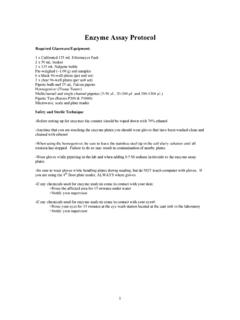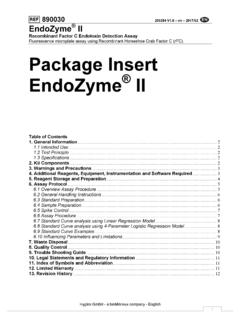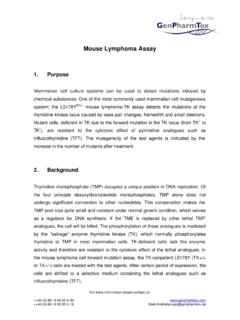Transcription of To maintain a validated assay status, howe …
1 1. Validation is a process that determines the fitness of an assay , which has been properly developed, optimised and standardised, for an intended purpose. All diagnostic assays (laboratory and field assays) should be validated for the species in which they will be used. Validation includes estimates of the analytical and diagnostic performance characteristics of a test. In the context of this chapter, an assay that has completed the first three stages of the validation pathway (see Figure 1. below), including performance characterisation, can be designated as validated for the original intended purpose(s) . To maintain a validated assay status , however, it is necessary to carefully monitor the assay 's performance under conditions of routine use, often by tracking the behaviour of assay controls over time. This ensures that the assay , as originally validated , consistently maintains its performance characteristics. Should it no longer produce results consistent with the original validation data, the assay may be rendered unfit for its intended purpose(s).
2 Thus, a validated assay is continuously assessed to assure it maintains its fitness for purpose through both the assessment of results of the assay controls included with each run and through on-going assessment during routine use in the targeted population. Assays applied to individuals or populations have many purposes, such as aiding in: documenting freedom from disease in a country or region, preventing spread of disease through trade, contributing to eradication of an infection from a region or country, confirming diagnosis of clinical cases, estimating infection prevalence to facilitate risk analysis, identifying infected animals toward implementation of control measures, and classifying animals for herd health or immune status post- vaccination. A single assay may be validated for one or more intended purposes by optimising its performance characteristics for each purpose, setting diagnostic sensitivity (DSe) high, with associated lower diagnostic specificity (DSp) for a screening assay , or conversely, setting DSp high with associated lower DSe for a confirmatory assay .
3 The ever-changing repertoire of new and unique diagnostic reagents coupled with many novel assay platforms and protocols has precipitated discussions about how to properly validate these assays. It is no longer sufficient to offer simple examples from serological assays, such as the enzyme-linked immunosorbent assay , to guide assay developers in validating the more complex assays, such as nucleic acid detection tests. In order to bring coherence to the validation process for all types of assays, this chapter focuses on the criteria that must be fulfilled during assay development and validation of all assay types. The inclusion of assay development as part of the assay validation process may seem counterintuitive, but in reality, three of the required validation criteria (definition of intended purpose[s], optimisation, and standardisation) that must be assessed in order to achieve a validated assay , comprise steps in the assay development process. Accordingly the assay development process seamlessly leads into an assay validation pathway, both of which require fulfilment of validation criteria.
4 Further, more detailed guidance is provided in a series of Recommendations for validation of diagnostic tests2 that are tailored for several fundamentally different types of assay ( detection of nucleic acids, antibodies, or antigens) and provide more information on specific issues related to the validation of diagnostic assays. For 1 assay , test method, and test are synonymous terms for purposes of this chapter, and therefore are used interchangeably. 2 Available at: specific information for wildlife species, refer to Chapter Principles and methods for the validation of diagnostic tests for infectious diseases applicable to wildlife. The information provided in chapter , which is specific to wildlife species, might also be useful for domestic animal test validation, for example, where the number or availability of samples is limited. All laboratories should comply with the requirements of Chapters (Aquatic Manual) or (Terrestrial Manual) on Quality management in veterinary testing laboratories.
5 This will minimise the influence of factors that do not depend on the test itself such as instrumentation, operator error, reagent choice (both chemical and biological) and calibration, reaction vessels and platforms, water quality, pH and ionicity of buffers and diluents, incubation temperatures and durations, and errors in the technical performance of the assay . The first step in assay development is to define the purpose of the assay , because this guides all subsequent steps in the validation process. assay validation criteria are the characterising traits of an assay that represent decisive factors, measures or standards upon which a judgment or decision may be based. By considering the variables that affect an assay s performance, the criteria that must be addressed in assay validation become clearer. The variables can be grouped into categories such as: (a) the sample individual or pooled, matrix composition, and host/organism interactions affecting the target analyte quantitatively or qualitatively; (b) the assay system physical, chemical, biological and operator-related factors affecting the capacity of the assay to detect a specific analyte in the sample; and (c) the test result interpretation the capacity of a test result, derived from the assay system, to predict accurately the status of the individual or population relative to the purpose for which the assay is applied.
6 Selection, collection, preparation, preservation and management of samples are critical variables in design and development of an assay to ensure valid test results. Other variables such as transport, chain of custody, tracking of samples, and the laboratory information management system are also key sources of variation/error that become especially important when the assay is implemented for routine testing. Integrity of experimental outcomes during assay development and validation is only as good as the quality of the samples used. Anticipating the factors that can negatively impact sample quality must precede launching an assay validation effort. Reference samples used in assay development and validation should be in the same matrix that is to be used in the assay ( serum, tissue, whole blood) and representative of the species to be tested by the assay . The reference materials should appropriately represent the range of analyte concentration to be detected by the assay .
7 Information on sample collection, preparation, preservation, management, and transport is available in chapters and of the Terrestrial Manual. The matrix in which the targeted analyte is found (serum, faeces, tissue, etc.) may contain endogenous or exogenous inhibitors that prevent some assays from working. This is of particular concern for enzyme-dependent tests such as polymerase chain reaction (PCR) or enzyme-linked immunosorbent assay (ELISA). Other factors that affect the concentration and composition of the target analyte (particularly antibody) in the sample may be mainly attributable to the host and are either inherent ( age, sex, breed, nutritional status , pregnancy, immunological responsiveness) or acquired ( passively acquired antibody, active immunity elicited by vaccination or infection). Non-host factors, such as contamination or deterioration of the sample, also potentially affect the ability of the assay to detect the specific targeted analyte in the sample.
8 It is also important that biological reagents are free of extraneous agents that might otherwise lead to erroneous results. assay performance is affected by many factors beginning with optimisation of the assay . After initial optimisation for an intended purpose, characteristics of the performance of the assay will be tested. The assay may need additional optimisation or may be found to be fit for purpose based on the results of the validation work. Criteria for assay Development and Validation i) Definition of the intended purpose(s). ii) Optimisation iii) Standardisation iv) Repeatability v) Analytical sensitivity vi) Analytical specificity vii) Thresholds (cut-offs). viii) Diagnostic sensitivity ix) Diagnostic specificity x) Reproducibility xi) Fitness for intended purpose(s). The OIE Standard for Management and Technical Requirements for Laboratories Conducting Tests for Infectious Diseases (World Organisation for Animal Health, 2008)3 states that test methods and related procedures must be appropriate for specific diagnostic applications in order for the test results to be of relevance.
9 In other words, the assay must be fit for purpose . The qualitative and quantitative assessment of capacity of a positive or negative test result to predict accurately the infection or exposure status of the animal or population of animals is the ultimate consideration of assay validation. This capacity is dependent on development of a carefully optimised and standardised (Section ) assay that, through accrual of validation data, provides confidence in the assay s ability to perform according to the intended purpose. In order to ensure that test results provide useful diagnostic inferences about animals or populations with regard to the intended purpose, the validation process encompasses initial development and assay performance documentation, as well as on-going assessment of quality control and quality assurance. Figure 1 shows the assay validation process, from assay design through the development and validation pathways to implementation, deployment, and maintenance of the assay The first step of assay development is selection of an assay type that is appropriate and that likely can be validated for a particular use (fitness for purpose).
10 The most common purposes are to: 1) Contribute to the demonstration of freedom from infection in a defined population (country/zone/compartment/herd) (prevalence apparently zero): 1a) Free with and/or without vaccination, 1b) Re-establishment of freedom after outbreaks 2) Certify freedom from infection or presence of the agent in individual animals or products for trade/movement purposes. 3) Contribute to the eradication of disease or elimination of infection from defined populations. 4) Confirm diagnosis of suspect or clinical cases (includes confirmation of positive screening test). 5) Estimate prevalence of infection or exposure to facilitate risk analysis (surveys, herd health status , disease control measures). 6) Determine immune status of individual animals or populations (post-vaccination). These purposes are broadly inclusive of many narrower and more specific applications of assays (see the Recommendations for validation of diagnostic tests: footnote 2) for each assay type for details).















